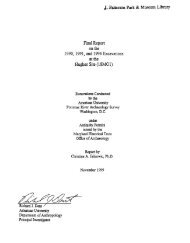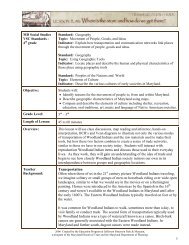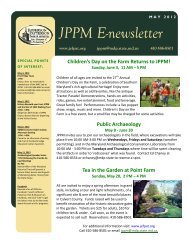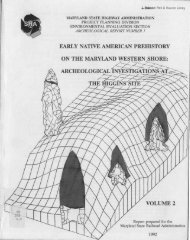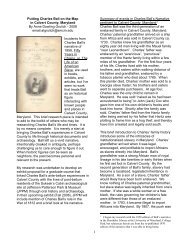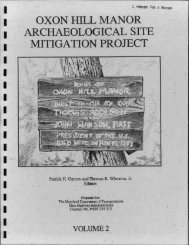Pre-Visit Lesson: What's in a shell? - Jefferson Patterson Park and ...
Pre-Visit Lesson: What's in a shell? - Jefferson Patterson Park and ...
Pre-Visit Lesson: What's in a shell? - Jefferson Patterson Park and ...
You also want an ePaper? Increase the reach of your titles
YUMPU automatically turns print PDFs into web optimized ePapers that Google loves.
Endur<strong>in</strong>g Underst<strong>and</strong><strong>in</strong>g<br />
<strong>Pre</strong>-<strong>Visit</strong> <strong>Lesson</strong>: What’s <strong>in</strong> a <strong>shell</strong><br />
The decl<strong>in</strong>e of resources is often the <strong>in</strong>dicator of environmental problems.<br />
Essential Questions<br />
What was the oyster population like when Europeans first arrived<br />
What human factors have contributed to the decl<strong>in</strong>e of the oyster population<br />
What environmental factors are <strong>in</strong>hibit<strong>in</strong>g the revitalization of the oyster population<br />
What Students Will Learn<br />
Students will be able to identify an oyster <strong>and</strong> the environmental conditions that are most<br />
favorable to its growth <strong>and</strong> population development.<br />
Students will ga<strong>in</strong> an underst<strong>and</strong><strong>in</strong>g of the historic oyster population.<br />
Students will ga<strong>in</strong> an underst<strong>and</strong><strong>in</strong>g of the current state of the oyster population.<br />
Students will identify human factors which have led to the decl<strong>in</strong>e of the oyster population.<br />
What Students Will Do<br />
Students will watch a brief movie on the oyster reefs <strong>and</strong> beds that would have greeted<br />
John Smith <strong>and</strong> be able to both describe the historic oyster population <strong>and</strong> how the<br />
physiology of oysters can describe environmental factors.<br />
Students will critically read articles about the current oyster population <strong>and</strong> population<br />
decl<strong>in</strong>e <strong>and</strong> discuss possible causes del<strong>in</strong>eated with<strong>in</strong> those articles.<br />
©2009 <strong>Jefferson</strong> <strong>Patterson</strong> <strong>Park</strong> & Museum All Rights Reserved. 1
<strong>Pre</strong>-<strong>Visit</strong> <strong>Lesson</strong>: What’s <strong>in</strong> a <strong>shell</strong><br />
Materials Needed<br />
Each Student will need –<br />
Program Notebook<br />
Copy of the Wash<strong>in</strong>gton Post June 2, 2008 article –<br />
“Oyster Sav<strong>in</strong>g Efforts a Wash <strong>in</strong> the Chesapeake Bay” by David Fahrenthold,<br />
Teacher will need –<br />
Oyster Shells<br />
Computer with <strong>in</strong>ternet connection<br />
LCD Projector<br />
Teacher will need to access the follow<strong>in</strong>g websites –<br />
Archives at The Wash<strong>in</strong>gton Post –<br />
http://www.wash<strong>in</strong>gtonpost.com/wpdyn/content/article/2008/06/01/AR2008060102499_pf<br />
.html<br />
National Geographic Jamestown Interactive -<br />
ngm.nationalgeographic.com/2007/05/jamestown/jamestown-st<strong>and</strong>alone<br />
Background Information<br />
This lesson <strong>in</strong>troduces students to the idea that changes <strong>in</strong> natural resources can serve as<br />
<strong>in</strong>dicators of the effects of human activities <strong>and</strong> l<strong>and</strong> use on the environment. The natural<br />
resource <strong>in</strong>vestigated <strong>in</strong> this lesson is the Eastern Oyster (Crassostrea virg<strong>in</strong>ica). In order to<br />
support the student discussion, the text from the Oyster Lifecycle <strong>in</strong>formation sheet <strong>in</strong> the<br />
student notebook is <strong>in</strong>cluded <strong>in</strong> this background section.<br />
Oysters have been eaten by people <strong>in</strong> the Chesapeake Bay region for thous<strong>and</strong>s of years.<br />
Most of the empty <strong>shell</strong>s were thrown away. These trash piles are known to archaeologists as<br />
<strong>shell</strong> middens <strong>and</strong> they offer a wealth of <strong>in</strong>formation about past cultures <strong>and</strong> environments.<br />
When <strong>shell</strong>s are found <strong>in</strong> a dated context, such as the 1610 Jamestown Well, they provide more<br />
<strong>in</strong>formation than just what the colonists had for d<strong>in</strong>ner. The size, shape, <strong>and</strong> condition of the<br />
<strong>shell</strong>s can be studied to learn about what the Chesapeake Bay was like 400 years ago.<br />
Oyster Lifecyle Read<strong>in</strong>g from Program Notebook page 6<br />
All along the bays <strong>and</strong> rivers of the Eastern United States can be found an adaptive bivalve<br />
mollusk known as the Eastern Oyster. These oysters are typically found <strong>in</strong> subtidal regions where<br />
the water depth ranges from 8 to 35 feet <strong>and</strong> the water sal<strong>in</strong>ity ranges between 5 to 40 parts per<br />
thous<strong>and</strong> (ppt.). The ideal sal<strong>in</strong>ity range for oyster growth occurs between 15 <strong>and</strong> 22 ppt.<br />
Oysters can survive <strong>in</strong> a variety of temperatures rang<strong>in</strong>g from -2 °Celsius (C) to 36 °C. (28°F –<br />
©2009 <strong>Jefferson</strong> <strong>Patterson</strong> <strong>Park</strong> & Museum All Rights Reserved. 2
<strong>Pre</strong>-<strong>Visit</strong> <strong>Lesson</strong>: What’s <strong>in</strong> a <strong>shell</strong><br />
97°F), but the more stable the temperature, the better rate of survival for this species. C.<br />
virg<strong>in</strong>ica particularly does not tolerate wide, sudden fluctuations of temperature.<br />
Temperature <strong>and</strong> water pH play an important role <strong>in</strong> oyster reproduction. As the water<br />
temperature rises to 20 degrees C, oysters beg<strong>in</strong> to spawn. This is part of the reason for the<br />
familiar l<strong>in</strong>e “Never eat an oyster <strong>in</strong> a month without an R.” May through August are the months<br />
when the water temperature <strong>in</strong> the Chesapeake Bay beg<strong>in</strong>s to approach the ideal spawn<strong>in</strong>g<br />
temperature for oysters. For oyster reproduction <strong>and</strong> growth, the water pH should be between<br />
6.25 <strong>and</strong> 8.5, <strong>and</strong> while oysters can survive outside of that range, their ability to produce<br />
offspr<strong>in</strong>g dim<strong>in</strong>ishes. Dissolved oxygen (DO) refers to the amount of oxygen that is present <strong>in</strong> the<br />
water. Fish, crabs <strong>and</strong> oysters that live or feed along the bottom require oxygen concentrations<br />
of 3 parts per million (ppm) <strong>and</strong> greater. Areas with less than 0.2 ppm of DO are unable to<br />
support most forms of life.<br />
The Eastern Oyster plays an important role <strong>in</strong> the ecology of the Bay. As a filter feeder, the<br />
oyster pulls plankton <strong>and</strong> other particles from the water by open<strong>in</strong>g its <strong>shell</strong> <strong>and</strong> forc<strong>in</strong>g water<br />
past its gills. This means that oysters assist <strong>in</strong> ma<strong>in</strong>ta<strong>in</strong><strong>in</strong>g the turbidity, or clarity, of the water<br />
that they live <strong>in</strong>. While some turbidity is normal, <strong>in</strong> general for the whole ecosystem low<br />
turbidity is better. High water clarity means that more sunlight reaches the submerged aquatic<br />
grasses that are also important to the Bay’s health.<br />
The oyster spat (young oyster) often settles upon other oysters form<strong>in</strong>g oyster reefs. These<br />
structures provide important homes to a variety of life forms <strong>and</strong> have a direct effect on the<br />
shape <strong>and</strong> movement of the waters of the Chesapeake Bay. Oysters are also an important food<br />
source to such mar<strong>in</strong>e life as blue crab <strong>and</strong> a variety of fish.<br />
There are many threats to the oysters <strong>in</strong> the Chesapeake Bay. While over-harvest<strong>in</strong>g may be<br />
the most familiar, human pollution has wreaked havoc on oyster populations. Oversedimentation,<br />
the presence of excessive nutrients result<strong>in</strong>g <strong>in</strong> excessive algae growth, <strong>and</strong><br />
heavy metal pollution are important factors <strong>in</strong> the degradation of oyster populations. Two<br />
common ways to measure the nutrients <strong>in</strong>volve look<strong>in</strong>g at nitrates <strong>and</strong> phosphates which enter<br />
the environment through many routes <strong>in</strong>clud<strong>in</strong>g raw sewage <strong>and</strong> fertilizer. Any level greater than<br />
1 ppt. can be harmful to the oyster. Additionally, two diseases have ravaged the Chesapeake Bay<br />
oysters. Dermo <strong>and</strong> MSX are two protozoan parasites that have <strong>in</strong>fected oysters with<strong>in</strong> the<br />
Chesapeake. Though not known to be dangerous to humans, these diseases pass from oyster to<br />
oyster <strong>and</strong> cause high mortality <strong>in</strong> their populations. Both diseases arrived <strong>in</strong> the Chesapeake Bay<br />
<strong>in</strong> the 1950’s.<br />
Suggested Sources<br />
Grumet, Robert, Bay, Pla<strong>in</strong>, <strong>and</strong> Piedmont: A L<strong>and</strong>scape History of the Chesapeake Heartl<strong>and</strong><br />
from 1.3 billion years ago to 2000, National <strong>Park</strong> Service, Annapolis, Maryl<strong>and</strong>, 2000 – available<br />
©2009 <strong>Jefferson</strong> <strong>Patterson</strong> <strong>Park</strong> & Museum All Rights Reserved. 3
<strong>Pre</strong>-<strong>Visit</strong> <strong>Lesson</strong>: What’s <strong>in</strong> a <strong>shell</strong><br />
on the Chesapeke Bay Program<br />
http://www.chesapeakebay.net/pubs/gateways/pla<strong>in</strong><strong>and</strong>piedmont/HF-WHOLE%20BOOK.pdf<br />
Kennedy, Victor S., Roger I.E. Newell, <strong>and</strong> Albert F. Eble, ed., The Eastern Oyster: Crassostrea<br />
virg<strong>in</strong>ica, Maryl<strong>and</strong> Sea Grant, College <strong>Park</strong>, Maryl<strong>and</strong>, 1996.<br />
Miller, Henry M. The Oyster <strong>in</strong> Chesapeake History. Historic St. Mary’s City.<br />
http://www.stmaryscity.org/Archaeology/Oyster%20<strong>in</strong>%20Chesapeake%20History.html<br />
For further <strong>in</strong>formation on oysters, water quality <strong>and</strong> resource issues, view the follow<strong>in</strong>g<br />
websites:<br />
Chesapeake Bay Program – About the Bay – Water Quality<br />
http://www.chesapeakebay.net/waterquality.aspxmenuitem=13945<br />
Maryl<strong>and</strong> Sea Grant – http://www.mdsg.umd.edu<br />
Filters on the Half Shell<br />
A. Ask students the follow<strong>in</strong>g question while show<strong>in</strong>g them an oyster <strong>shell</strong>.<br />
Can anyone identify the object that I am hold<strong>in</strong>g <strong>in</strong> my h<strong>and</strong><br />
B. Expla<strong>in</strong> to the students that what you have is the <strong>shell</strong> of an oyster; a <strong>shell</strong>fish that plays an<br />
important role <strong>in</strong> Maryl<strong>and</strong>’s economic <strong>and</strong> environmental well be<strong>in</strong>g.<br />
C. Ask the students a few questions to show how this creature may directly affect them.<br />
How many of the students fish either <strong>in</strong> the Chesapeake Bay or one of its<br />
tributaries<br />
How many have family members who do<br />
How many students go out to eat at local seafood restaurants or eat locally caught<br />
seafood at home<br />
How many of them have family members who are watermen for a liv<strong>in</strong>g now or <strong>in</strong><br />
the past<br />
How many ever go to the Chesapeake Bay or any of its tributaries to swim, boat,<br />
or just play around<br />
D. Expla<strong>in</strong> that today we are look<strong>in</strong>g at an animal that plays an important role <strong>in</strong> all of the<br />
activities we talked about just now. Have the students read the <strong>in</strong>formation sheet on the<br />
©2009 <strong>Jefferson</strong> <strong>Patterson</strong> <strong>Park</strong> & Museum All Rights Reserved. 4
<strong>Pre</strong>-<strong>Visit</strong> <strong>Lesson</strong>: What’s <strong>in</strong> a <strong>shell</strong><br />
oyster on page 6 of the Notebook. Have them answer the follow<strong>in</strong>g questions <strong>in</strong> their<br />
Notebooks on page s 7 – 8:<br />
1. What type of water do oysters prefer<br />
2. Are there any special temperatures that they prefer, or is it just stable<br />
temperatures<br />
3. Are there any other environmental factors such as acidity or nutrients that are<br />
important to oyster growth<br />
4. Where are oysters <strong>in</strong> the food cha<strong>in</strong><br />
5. Oysters are often called the “filters of the bay.” Why<br />
6. If the population of oysters has significantly decreased <strong>and</strong> they can’t filter as<br />
much algae <strong>and</strong> nutrients as <strong>in</strong> the past, could this cause a problem for the<br />
Chesapeake Bay<br />
7. Fill out the “Ideal for Oysters” column <strong>in</strong> Water Quality Chart 1 on page 14 <strong>in</strong> the<br />
Notebook.<br />
Go<strong>in</strong>g, Go<strong>in</strong>g, Gone<br />
A. Now pass out the Wash<strong>in</strong>gton Post article “Oyster Sav<strong>in</strong>g Efforts a Wash <strong>in</strong> the Chesapeake<br />
Bay” by David Fahrenthold, dated June 2, 2008.<br />
B. Have the students read the article <strong>and</strong> answer the follow<strong>in</strong>g questions on pages 9 - 10 <strong>in</strong><br />
their Notebooks:<br />
1. What are three factors that have lead to the steady decl<strong>in</strong>e of the oyster<br />
population<br />
2. How does Kennedy Paynter describe the role of the oyster reefs of the Chesapeake<br />
Bay<br />
3. Approximately how many watermen oystered <strong>in</strong> the Chesapeake Bay <strong>in</strong> the 1980’s<br />
4. How many watermen harvested oysters between 2002 <strong>and</strong> 2006 What has<br />
happened to the number of watermen from the 1980’s to the 2000’s<br />
©2009 <strong>Jefferson</strong> <strong>Patterson</strong> <strong>Park</strong> & Museum All Rights Reserved. 5
<strong>Pre</strong>-<strong>Visit</strong> <strong>Lesson</strong>: What’s <strong>in</strong> a <strong>shell</strong><br />
5. Name one method that the State of Maryl<strong>and</strong> has used <strong>in</strong> an attempt to create<br />
new oyster habitats.<br />
6. Approximately how much of the oysters harvested by watermen were supplied by<br />
that method<br />
7. What percent of the historic Chesapeake Bay oyster population does today’s<br />
oyster population represent<br />
8. What is the Army Corps of Eng<strong>in</strong>eers do<strong>in</strong>g to its oyster reefs that is different from<br />
other man made reefs <strong>in</strong> the Chesapeake Bay region<br />
9. What are two possible new oyster strategies mentioned <strong>in</strong> the article<br />
10. Based on what you have read, what do you th<strong>in</strong>k the chances are that the oyster<br />
population of the Chesapeake will beg<strong>in</strong> to make a comeback<br />
What can they teach us<br />
A. While the current outlook for oysters may not be so good; historically oysters played an<br />
important role <strong>in</strong> the diet of Native Americans <strong>and</strong> European Colonists alike. In addition to<br />
the <strong>in</strong>formation about what people who once lived here ate, oysters are also provid<strong>in</strong>g a lot<br />
of <strong>in</strong>formation about the environment of the Chesapeake Bay region 400 years ago.<br />
Go to the Jamestown Interactive on the National Geographic website <strong>and</strong> play the video<br />
called “Clues <strong>in</strong> Oysters.” The video is found <strong>in</strong> the Explore Jamestown section of the<br />
<strong>in</strong>teractive, under “Impact of Colonization.” In it, Juliana Hard<strong>in</strong>g tells us about the<br />
important <strong>in</strong>formation conta<strong>in</strong>ed <strong>in</strong> the oyster <strong>shell</strong>s found by archaeologists <strong>in</strong> the<br />
Jamestown Well.<br />
B. While the students watch both sections of the video, have them answer the follow<strong>in</strong>g<br />
questions <strong>in</strong> their Notebooks on page 11 - 12:<br />
1. Where did the oyster <strong>shell</strong>s used <strong>in</strong> Ms. Hard<strong>in</strong>g’s study come from<br />
2. Is it important to know where <strong>and</strong> when the oyster <strong>shell</strong>s came from Why<br />
3. Why could oysters have posed problems for Capt. John Smith<br />
4. In what way can the oyster reefs found <strong>in</strong> the Chesapeake support other aspects of<br />
the environment<br />
©2009 <strong>Jefferson</strong> <strong>Patterson</strong> <strong>Park</strong> & Museum All Rights Reserved. 6
<strong>Pre</strong>-<strong>Visit</strong> <strong>Lesson</strong>: What’s <strong>in</strong> a <strong>shell</strong><br />
5. Why do researchers call oysters a “Keystone Species”<br />
6. Why might not hav<strong>in</strong>g seen an undisturbed oyster population have an effect on the<br />
modern day restoration efforts<br />
What do you th<strong>in</strong>k<br />
After discuss<strong>in</strong>g their answers from the previous section have the students answer the follow<strong>in</strong>g<br />
questions on page 13 <strong>in</strong> their Notebooks:<br />
1. Based on what you learned today, how much effort <strong>and</strong> money do you feel should<br />
be devoted to the study <strong>and</strong> restoration of oysters Expla<strong>in</strong> why us<strong>in</strong>g <strong>in</strong>formation<br />
from today’s lesson.<br />
2. Th<strong>in</strong>k back to the description of your neighborhood that you wrote <strong>in</strong> People &<br />
Places <strong>Lesson</strong> (page 2 of Program Notebook). How might what you see <strong>in</strong> your<br />
environment, be it farms or asphalt <strong>and</strong> sidewalks, affect the oyster population <strong>in</strong><br />
the Chesapeake based on what you read today<br />
©2009 <strong>Jefferson</strong> <strong>Patterson</strong> <strong>Park</strong> & Museum All Rights Reserved. 7



